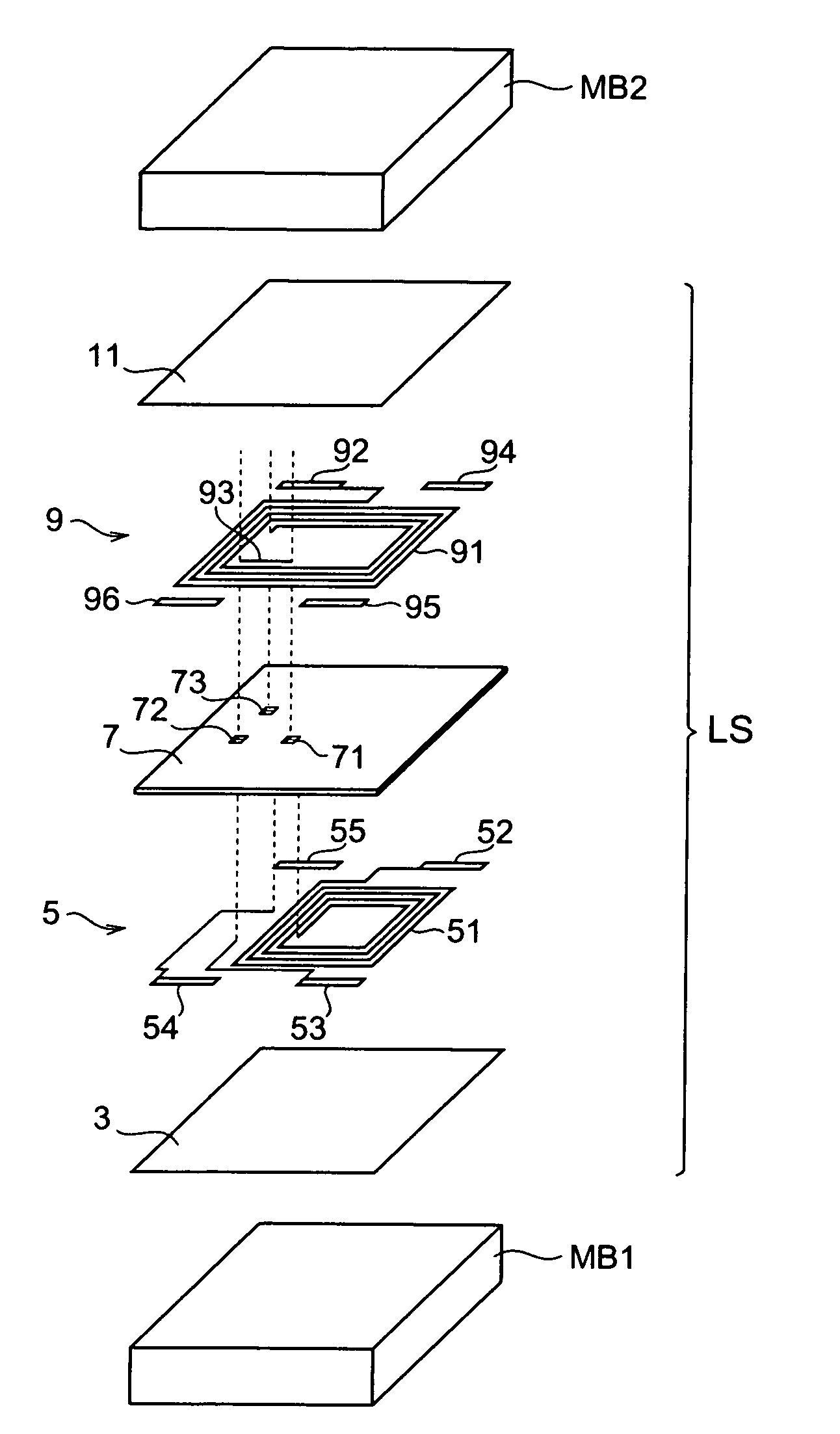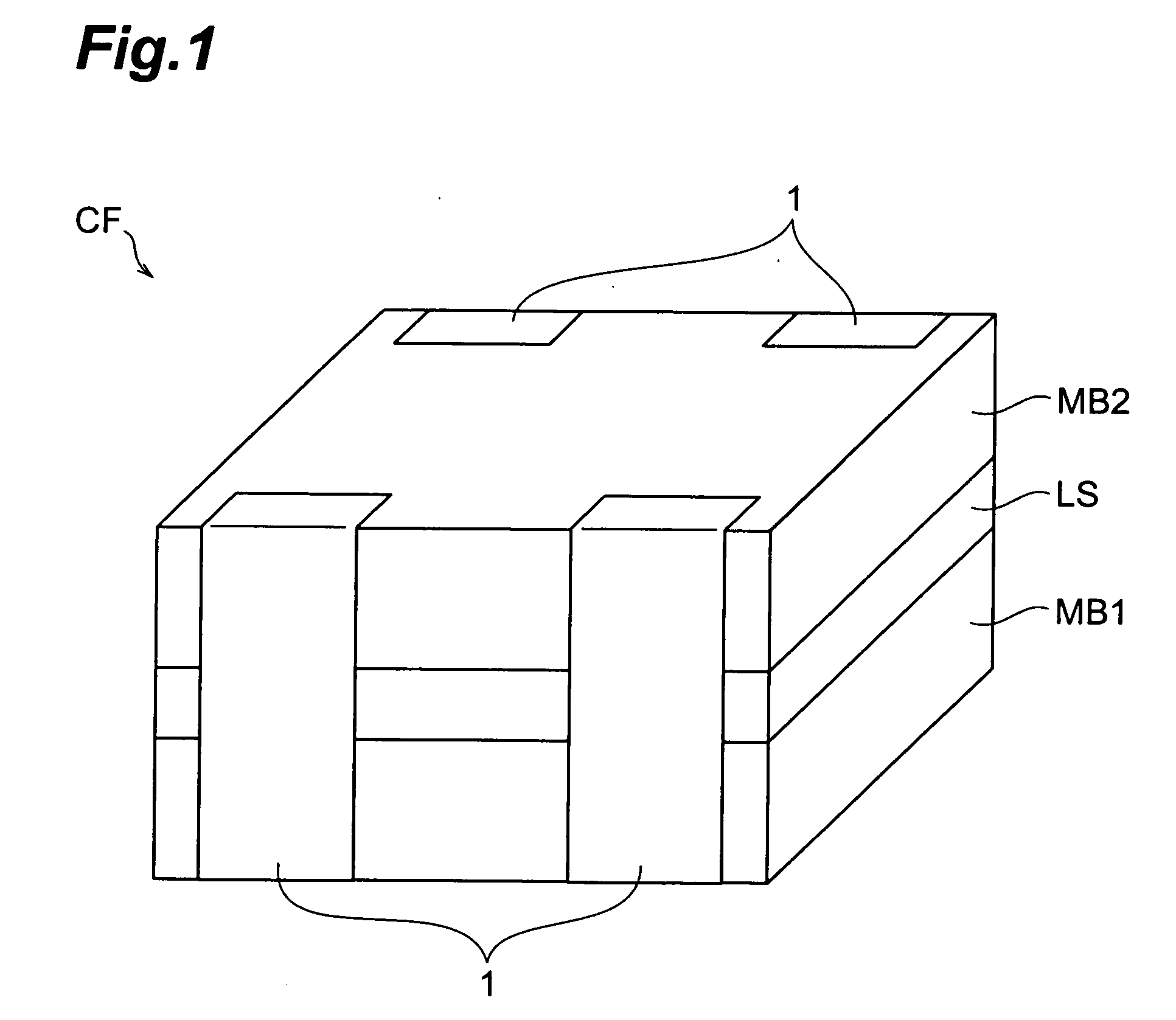Common-mode filter
- Summary
- Abstract
- Description
- Claims
- Application Information
AI Technical Summary
Benefits of technology
Problems solved by technology
Method used
Image
Examples
first embodiment
[0032] A common-mode filter which is a first embodiment will be explained with reference to FIG. 1. FIG. 1 is a perspective view showing a common-mode filter CF.
[0033] As shown in FIG. 1, the common-mode filter CF is a common-mode filter of a thin film type comprising a first magnetic substrate MB1, a layer structure LS, and a second magnetic substrate MB2. Terminal electrodes 1 are formed on the outer peripheral face of the multilayer body constructed by the first magnetic substrate MB1, layer structure LS, and second magnetic substrate MB2. The terminal electrodes 1 are formed such as to extend from the first magnetic substrate MB1 to the second magnetic substrate MB2 by way of the layer structure LS. The terminal electrodes 1 are formed by two pairs on two opposing side faces of the above-mentioned multilayer body.
[0034]FIG. 2 is a schematic view showing the common-mode filter CF in an exploded fashion. The layer structure LS will be explained with reference to FIG. 2. As shown...
second embodiment
[0065] A common-mode filter which is a second embodiment of the present invention will be explained with reference to FIG. 4. FIG. 4 is a perspective view showing a common-mode filter CF2.
[0066] As shown in FIG. 4, the common-mode filter CF2 is a common-mode filter of a thin film type comprising a first magnetic substrate MB3, a layer structure LS2, and a second magnetic substrate MB4. Terminal electrodes 2 are formed on the outer peripheral face of the multilayer body constructed by the first magnetic substrate MB3, layer structure LS2, and second magnetic substrate M4. The terminal electrodes 2 are formed such as to extend from the first magnetic substrate MB3 to the second magnetic substrate MB4 by way of the layer structure LS2. The terminal electrodes 2 are formed by four pairs on two opposing side faces of the above-mentioned multilayer body.
[0067]FIG. 5 is a schematic view showing the common-mode filter CF2 in an exploded fashion. The layer structure LS2 will be explained w...
third embodiment
[0125] A common-mode filter which is a third embodiment of the present invention will be explained with reference to FIG. 8. The common-mode filter of this embodiment is provided with a first conductor layer 205, a second insulating layer 207, and a second conductor layer 209, which are shown in FIG. 8, in place of the first conductor layer 5, second insulating layer 7, and second conductor layer 9 in the common-mode filter CF of the first embodiment.
[0126] The first conductor layer 205 is formed on the first insulating layer 3 (see FIG. 2). As shown in (a) in FIG. 8, the first conductor layer 205 has a spiral part (second spiral part) 251, a lead electrode 252, a lead electrode 253 (second lead electrode), a lead electrode 254, a lead electrode 255, and a connecting conductor 256. The lead electrodes 252, 253 are arranged on one side of the first insulating layer 3, whereas the lead electrodes 254, 255 are arranged on one side of the first insulating layer 3 opposing the side ther...
PUM
 Login to View More
Login to View More Abstract
Description
Claims
Application Information
 Login to View More
Login to View More - R&D Engineer
- R&D Manager
- IP Professional
- Industry Leading Data Capabilities
- Powerful AI technology
- Patent DNA Extraction
Browse by: Latest US Patents, China's latest patents, Technical Efficacy Thesaurus, Application Domain, Technology Topic, Popular Technical Reports.
© 2024 PatSnap. All rights reserved.Legal|Privacy policy|Modern Slavery Act Transparency Statement|Sitemap|About US| Contact US: help@patsnap.com










